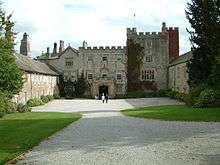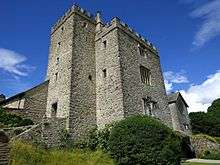Sizergh Castle and Garden

Sizergh Castle and Garden is a stately home and garden at Helsington in the English county of Cumbria, about 4 miles (6.4 km) south of Kendal. The castle, a grade I listed building,[1] is in the care of the National Trust along with its garden and estate.
In 2016 the Sizergh estate was included in the newly extended Lake District National Park.[2]
Details

The earliest part of the building is a tower of fourteenth or fifteenth century date.[1]
Woodwork
There are oak-panelled interiors, including the Inlaid Chamber, where the panelling is inlaid with floral and geometric patterns in pale poplar and dark bog-oak. The contents of the Inlaid Chamber were sold to the Victoria and Albert Museum (V&A) in the 1890s and it was displayed as a reconstructed period room. The return of the panelling to its original location at Sizergh was advocated by among others Mark Girouard. The panelling returned in 1999 under a long-term loan.[3]
The bargeboards probably date from the seventeenth century.
Paintings
The Castle contains a variety of paintings, including the following:
- a collection of portraits of the Catholic Royal Stuart family reflects the Strickland family's links to the Jacobite court in exile at Saint-Germain-en-Laye. There are portraits by Alexis Simon Belle, painter in ordinary to James VII & II and the Old Pretender, of Queen Mary of Modena and her daughter Princess Louisa Maria.[4]
- Strickland family portraits, including works by local artist George Romney,[5] a portrait of Mrs Anne Strickland (the artist's mother) by Harriet Strickland (1816–1903),[6] and a portrait of Lady Edeline Sackville.[7]
History
The Deincourt family owned this land from the 1170s. On the marriage of Elizabeth Deincourt to Sir William de Stirkeland in 1239, the estate passed into the hands of what became the Strickland family, who owned it until it was gifted to the National Trust in 1950 by Gerald Strickland, 1st Baron Strickland's grandson Lt. Cdr. Thomas Hornyold-Strickland, 7th Count della Catena.[8]
Catherine Parr, the sixth wife of Henry VIII and a relative of the Stricklands, is thought to have lived here after her first husband died in 1533. Catherine's second husband, Lord Latymer, was kin to the dowager Lady Strickland.[9][10]
It was extended in Elizabethan times. Sir Thomas Strickland went into exile with James II.
Around 1770, the great hall was again expanded in the Georgian style.
Media interest
The Castle was featured in the ITV documentary Inside the National Trust.[11]
Garden

The garden has a lake and a kitchen garden as well as an award-winning rock garden. The rock garden, which was constructed in the 1920s, is the largest limestone rock garden belonging to the National Trust. It includes part of the National Collection of hardy ferns.
Estate
In 1336 a grant from Edward III allowed Sir Walter Strickland to enclose the land around Sizergh as his exclusive park.
The estate covers 647 hectares (1,600 acres).[12]
Biodiversity
There are various types of habitat. These were enhanced within the context of the Morecambe Bay Nature Improvement Area which received three years of government grant funding (2012–15).
Birds
The Sizergh estate is a good place to see birds. For example, hawfinches are attracted to the area because of its hornbeam trees, and these birds sometimes come close to the main car park.[13][14]
In 2014 it was reported that 35 ha of wetland habitat was being created in the Lyth Valley on the western edge of the estate. The project has received funding from Natural England as part of a higher level stewardship scheme. It is hoped to attract bittern and other wildlife.[15]
Butterflies
Fritillary butterflies live on the estate.[16]
See also
References
- 1 2 Historic England. "Sizergh Castle (1318962)". National Heritage List for England. Retrieved 10 July 2015.
- ↑ "Yorkshire Dales and Lake District national parks to be extended". October 2015. Retrieved 6 August 2016.
- ↑ "Inlaid Room at Sizergh Castle". Victoria and Albert Museum. Retrieved 31 March 2015.
- ↑ Corp, Edward, Belle, Alexis-Simon (1674–1734) in Oxford Dictionary of National Biography. Oxford University Press, September 2004 (subscription or UK public library membership required for online access)
- ↑ Walter Strickland (1729 - 1761). National Trust Collections
- ↑ Anne Cholmeley (1796–1829), Mrs Jarrard Edward Strickland
- ↑ Lady Edeline Sackville (1870–1918), Lady Strickland. Your Paintings
- ↑ "Meet Henry Hornyold-Strickland, Sizergh". National Trust.
- ↑ Susan E. James. Catherine Parr: Henry VIII's Last Love. The History Press, 2008, 2009. pg 56.
- ↑ Linda Porter, Katherine the Queen. Macmillan, 2010. pg 58.
- ↑ "Video: 'Inside the National Trust': preview". The Daily Telegraph. 12 October 2013.
- ↑ "Sizergh - Visitor information". National Trust. Retrieved 2012-10-03.
- ↑ Our elusive hawfinch
- ↑ "Hawfinch recovery project". Local Nature Partnership. Retrieved 7 January 2015.
- ↑ Dickinson, Katie. "Park End Moss aims to bring wildlife flooding in". Westmorland Gazette. Retrieved 21 November 2014.
- ↑ The Best Places to Photograph Wildlife in the UK
External links
| Wikimedia Commons has media related to Sizergh Castle. |
- Sizergh Castle & Garden information at the National Trust
- Sizergh Castle garden
- Paintings at Sizergh, Art UK
- Illustrated guide to Sizergh Castle
- The Cumbria Directory - Sizergh Castle Garden
Coordinates: 54°17′04″N 2°46′19″W / 54.28444°N 2.77194°W